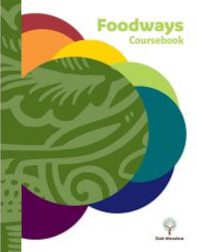The Foodways course is listed under social studies for high school on the Oak Meadow website, although you might think that a course about food would fall under science. While the course teaches a great deal about the science of food, agriculture, and the food industry, the course’s ultimate theme is the promotion of sustainable food systems which brings it closer to the realm of social studies. This reflects the Waldorf philosophy taught through Oak Meadow.
The Foodways course description explains that this course “explores the many interconnected systems that work together to bring food from the farm to our tables. Learning about sustainable food systems helps us understand how our food choices impact our communities and the wider world, and allows us to make more effective and intentional decisions about what we eat.” This description helps to explain why the course is offered in the social studies realm, but you might also use it as an elective.
Foodways is a one-semester course that is presented in a 69-page coursebook. There is no textbook, but students will choose one non-fiction title from a list of 15 books, read the book, and write a 500-word essay about it. The titles of the books, such as Stuffed and Starved: The Hidden Battle of the World Food System and Consumed: Food for a Finite Planet, give you an idea of the viewpoint advocated by this course. Throughout the course, a large number of resources are accessed through links on a dedicated page for the course maintained by Oak Meadow. (While Oak Meadow has curated the list of links, the actual websites are not under Oak Meadow’s control.) Resources at these websites include 25 videos (many on YouTube®), 13 articles, a USDA report, a photo essay, an interactive map, a map for finding local farmers' markets, and a documentary.
Students will do a significant amount of additional, independent research beyond the linked resources. For instance, Lesson 5 tells students to learn about both organic farming and permaculture, then write a comparison essay in regard to their key features. Students are on their own to locate resources for this. They are instructed to use MLA formatting for their essay citations. Another activity requires students to create a slide presentation on sustainable farming methods currently being used at one farm. It can be a farm in the student’s area or one for which they can obtain enough information and images online or in some other manner.
Students will do a final project that involves service learning. They might volunteer to work at a local farm, or they can create something that helps to promote a local effort to provide access to healthy food—maybe for a farmers market, food pantry, local farm, or other business or organization. The project should take ten to fifteen hours over two or three weeks, and students will write up a brief report about it.
Students who want to go deeper on some topics or to complete additional projects can use the suggestions found in call-out boxes titled “Up for a Challenge?”
Summary
The Foodways course will raise a student’s awareness of the importance of developing sustainable food systems around the world. The course will probably be most practical for those living in an area where farms, community gardens, and farmers markets are readily accessible, especially if some of them are already working on sustainability.









